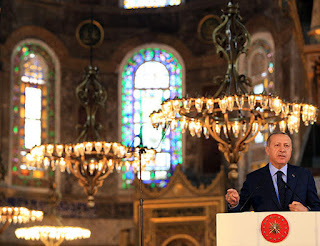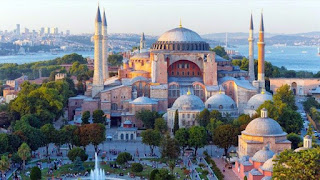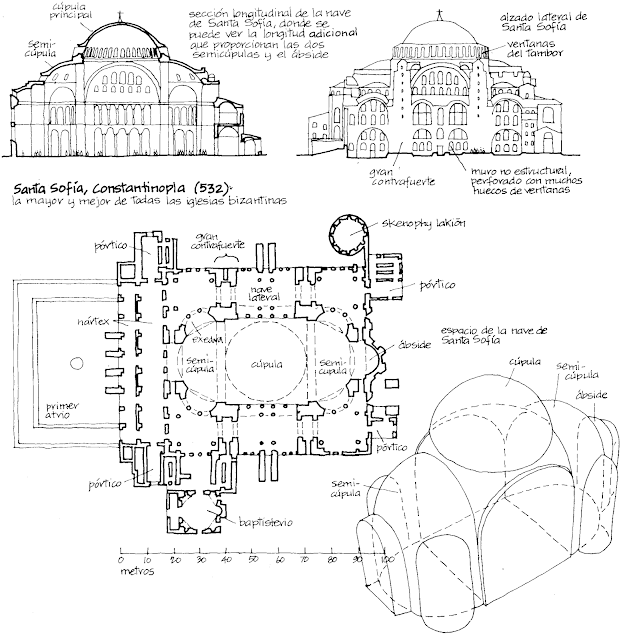On July 25th, 2020 the first Muslim prayer after the reversion took
place in the ancient basilica. The Turkish Islamic government has canceled the
museum status of the building, a tittle it has held since the 20th century.
The building has been an Orthodox cathedral, a Catholic
cathedral, a mosque and, more recently, a museum.
The first construction in the place where is located today
the mosque was the Church of the Divine Wisdom of Christ, founded in 360 by
order of the roman emperor Constantine II. But it suffered a fire in 404. The
building was a wooden-roofed basilica. As written in the Chronicon Paschale (annals
of the 7th century about the Christian world), the emperor made “many
offerings, namely, large gold and silver vessels and many covers for the saint
altar woven with gold and precious stones, and also several golden curtains for
the doors of the church and others of gold cloth for the external doors”.
About the second Hagia Sophia, consecrated in 405 by the
roman emperor Theodosius II, only part of the portico (currently in the garden
of the current mosque) remains after being destroyed by the Nika insurrection
in 532. The famous popular revolt that took place in Constantinople (current Istanbul)
in 532 was motivated by the tax increases decreed by the emperor due to the
constant war on the eastern border of the Empire and the conflict between the
two branches of Christianity: Orthodox and Monophysite. The Orthodox defended
the duality of the nature of Jesus Christ, divine and human without separation.
While the Monophysitism separated the two natures of the son of God, but the
human was absorbed by the divine. The faith professed by the emperor and his
wife was orthodox. People from a humbler social position were monophysite. The
emperor, with the aim of calming the atmosphere, organized a horse race,
however at Nika’s scream the entire racecourse turned against him. The emperor
fled and that further angered the people. Thus, a revolt began. The revolt burned
and destroyed publica buildings, including Hagia Sophia.
After the revolt, Justinian I rebuilt many of the public buildings
that had been destroyed. The creation of the Hagia Sophia that we know today
began. Construction lasted only six years, an achievement considering that some
of the Gothic cathedrals took almost a century.
The new basilica was consecrated
on December 26, 537. The church has since been considered a symbol of Byzantine
power. It embodies both imperial ideal and Christian worship.
The space it
occupies within the city is also significant, crowing a hill, it encourages
admiration.
In the 6th century, Constantinople reached its maximum splendor.
The chosen architects were Anthemius of Tralles and Isidore of
Miletus. At the time it was common for two technicians to be in charge of
monumental works. One, the theorist, thought up the plan on which to construct
the building and the other, the technician, shaped up the idea.
Anthemius was
the theoretician, he was an expert in descriptive geometry and, according to
the Byzantine historian Agatias, he must have knowledge of painting and
sculpture. Isidore was the technician, and the author of an annotated edition
of the second book by the Greek physicist, engineer, inventor, astronomer and
mathematician Archimedes, devoted to the sphere and cylinder, and author of a
commentary on the vaulting treatise of the Hellenistic engineer and
mathematician Heron of Alexandria.
Taking into account the knowledge of these
architects, the constructive characteristics of the elements of the basilica
and the historical period in which it was built, it could be said that it was
the last creation of ancient architecture.
The design has no background. It is made up of current elements
from the time such as the basilica plant and the roundabout, which, combined, constitute
a new building based on a dome. A counter system was used by means of two
semi-domes arranged on the longitudinal axis of the space, that is, in the east
and west wings of the building. These semi-domes rested on two small niches
arranged diagonally in relation to the axis. This system was completely
original since it rejected both the rows of columns that separated the naves of
the basilica and the structures with concentric ambulatory spaces (walkable
space behind the presbytery and the altar that allows access to the chapels
located in the apse).
The building enclosure was over 1 000 square meters with
a 31 meters diameter dome suspended in midair. A perfect foundation plan was devised,
and all the main supporting elements were built of stone. The outer structure was
made thinner, but large stone blocks were used up to a height of 7 meters. On
the main pillars, of 44 meters each, 4 large arches were laid. On the vertexes
of the arches, and the irregular pendentives that unite them, the main dome was
raised, consisting of a gallon shell with 40 ribs and 40 curved accessories,
reinforced on the outside by 40 short ribs placed at narrow intervals that
frame small windows.
The aforementioned system was adopted on the east-west axis.
In the transverse axis, walls with perforated eardrums were used to crown a set
of arcades supported by columns on two floors. On the lower floor, 4 huge
shafts form a kind of veil; on the upper floor, 6 columns support the eardrum.
Behind these colonnades are two superimposed galleries, covered with groin
vaults, in which two powerful pillars serve to counter the pressure of the
central dome.
Despite the complex plan established, during construction some
problems caused the base of the dome to be larger than planned. However, the
dome, built on the base of bricks set on edge joined with thick mortar beds,
was finally finished.
However, a series of earthquakes that shook the city
between 553 and 557 caused its collapse in 558.
On the recommendation of the architect Isidore the younger,
the southern and northern arches were progressively widened by the intrados (the
lower surface of an arch or vault) from the imposts to the key so that the
central space was closer to the square, raising the dome, in the year 563, up
to 56 meters high (from the original 51).
Although some repairs were necessary,
for example after an earthquake in 975, Isidore’s design has not been significantly
altered.
The building was completed by a large atrium in the west
that gave way to an exonarthex and a narthex, reaching a total area of more than
10 000 square meters.
The temple of Hagia Sophia shows characteristics of Byzantine architecture such as: the outward is austere, round arch and barrel vault, the dome rests on pendentives and the luminosity is achieved thanks to the decoration with mosaics.
Constantinople became one of the richest and most important
cities in the world. Hagia Sophia was the headquarter of the city’s Orthodox
Patriarch.
In 1204, the fourth crusade invaded and looted the city.
Hagia Sophia became a Catholic cathedral.
In 1453, the fall of Constantinople is considered the end of
the Middle Ages. Sultan Mehmet II of the Ottoman Empire set out to take the
city. Women, children, the elderly and the sick took refugee in the cathedral.
The city was bombed for 53 days. On May 29, 1453 the Ottoman Empire took over the
city, marking the end of the Byzantine world. This is the moment when the name
of the city changes to Istanbul (in Turkish Istanbul means “in the city” or “to
the city”; Constantinople was for the Byzantines and I Polis: “the City”). The Hagia
Sophia cathedral became a mosque. Minarets were added at each of its comers and,
inside, panels with the name of Ala, Muhammad and his grandchildren were erected.
The ornamentation changed remarkably with the Orthodox symbols being covered
with plaster. The most important change was the construction of a mihrab (which
indicates the orientation where to the Muslims should pray, Mecca). Hagia
Sophia was the main mosque in Istanbul until the construction of the Blue
Mosque in 1616.
The Ottoman Empire was defeated in World War I and its
territory distributed between the victorious allies. Out of its rubble emerged
the modern state of Turkey, proclaimed republic in 1923. The country’s founder
and first secular president, Mustafá Kemal Atatürk, ordered Hagia Sophia to be
converted into a museum. In 1935, Hagia Sophia was opened to the public as a
museum.
Sources:
Ventura, D. (2020). Santa Sofía: la ingeniosa arquitectura que le ha permitido a la estructura bizantina más importante mantenerse en pie tras 1.500 años de terremotos, asedios y conquistas. BBC News Mundo
ArteHistoria. Santa Sofía de Constantinopla
ArteHistoria. Contexto Santa Sofía
Glosario Mirabilia Ovetensia. "Deambulatorio".
Los disturbios de la Nika. Sergio Alejo
BBC News Mundo. La fascinante historia de Santa Sofía, el monumento que 15 siglos después de su construcción vuelve a enfrentar a Grecia y Turquía.
ArteHistoria. Santa Sofía de Constantinopla
ArteHistoria. Contexto Santa Sofía
Glosario Mirabilia Ovetensia. "Deambulatorio".
Los disturbios de la Nika. Sergio Alejo
BBC News Mundo. La fascinante historia de Santa Sofía, el monumento que 15 siglos después de su construcción vuelve a enfrentar a Grecia y Turquía.





